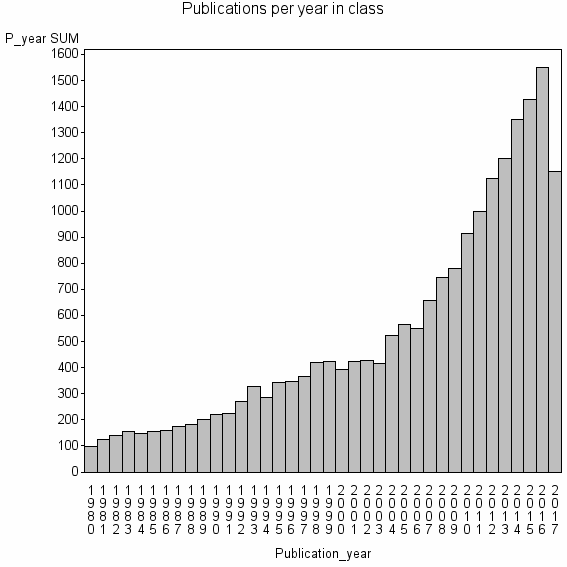
Class information for: |
Basic class information |

Hierarchy of classes |
The table includes all classes above and classes immediately below the current class. |
Terms with highest relevance score |
| rank | Category | termType | chi_square | shrOfCwithTerm | shrOfTermInClass | termInClass |
|---|---|---|---|---|---|---|
| 1 | INSOMNIA | authKW | 1396370 | 9% | 50% | 1776 |
| 2 | SLEEP | authKW | 1183157 | 15% | 25% | 3062 |
| 3 | SHIFT WORK | authKW | 950255 | 4% | 71% | 851 |
| 4 | SLEEP DURATION | authKW | 768353 | 3% | 79% | 619 |
| 5 | CHRONOTYPE | authKW | 482922 | 2% | 82% | 375 |
| 6 | SLEEPINESS | authKW | 418372 | 3% | 49% | 546 |
| 7 | CHRONOBIOLOGY INTERNATIONAL | journal | 410132 | 4% | 33% | 781 |
| 8 | ACTIGRAPHY | authKW | 395532 | 3% | 43% | 582 |
| 9 | SEASONAL AFFECTIVE DISORDER | authKW | 394243 | 2% | 74% | 337 |
| 10 | SLEEP DEPRIVATION | authKW | 369460 | 3% | 34% | 698 |
Web of Science journal categories |
| chi_square_rank | Category | chi_square | shrOfCwithTerm | shrOfTermInClass | termInClass |
|---|---|---|---|---|---|
| 1 | Clinical Neurology | 56136 | 24% | 1% | 4776 |
| 2 | Psychiatry | 32956 | 15% | 1% | 3084 |
| 3 | Ergonomics | 26047 | 3% | 3% | 694 |
| 4 | Neurosciences | 25544 | 22% | 0% | 4486 |
| 5 | Physiology | 12665 | 9% | 1% | 1890 |
| 6 | Biology | 10248 | 7% | 1% | 1403 |
| 7 | Public, Environmental & Occupational Health | 8460 | 10% | 0% | 1940 |
| 8 | Psychology | 7224 | 5% | 1% | 924 |
| 9 | Psychology, Applied | 6627 | 3% | 1% | 617 |
| 10 | Psychology, Developmental | 6246 | 3% | 1% | 679 |
Address terms |
| chi_square_rank | term | chi_square | shrOfCwithTerm | shrOfTermInClass | termInClass |
|---|---|---|---|---|---|
| 1 | SLEEP | 146214 | 2% | 20% | 478 |
| 2 | SLEEP MED | 146068 | 2% | 21% | 448 |
| 3 | SLEEP CHRONOBIOL | 115600 | 1% | 54% | 136 |
| 4 | CHRONOBIOL | 94311 | 1% | 26% | 228 |
| 5 | SLEEP DISORDERS | 86101 | 2% | 17% | 326 |
| 6 | NORWEGIAN COMPETENCE SLEEP DISORDERS | 85264 | 0% | 59% | 91 |
| 7 | BIOL RHYTHMS | 82774 | 0% | 82% | 64 |
| 8 | BODY RHYTHMS SHIFTWORK | 58377 | 0% | 97% | 38 |
| 9 | SLEEP PERFORMANCE | 52006 | 0% | 49% | 68 |
| 10 | SLEEP MOOD DISORDERS | 45724 | 0% | 100% | 29 |
Journals |
| chi_square_rank | term | chi_square | shrOfCwithTerm | shrOfTermInClass | termInClass |
|---|---|---|---|---|---|
| 1 | SLEEP | 556912 | 6% | 28% | 1267 |
| 2 | CHRONOBIOLOGY INTERNATIONAL | 410132 | 4% | 33% | 781 |
| 3 | JOURNAL OF SLEEP RESEARCH | 304354 | 3% | 36% | 536 |
| 4 | SLEEP MEDICINE | 282033 | 3% | 27% | 657 |
| 5 | BEHAVIORAL SLEEP MEDICINE | 197547 | 1% | 68% | 185 |
| 6 | SLEEP AND BIOLOGICAL RHYTHMS | 123406 | 1% | 42% | 187 |
| 7 | SLEEP MEDICINE REVIEWS | 110097 | 1% | 32% | 219 |
| 8 | JOURNAL OF CLINICAL SLEEP MEDICINE | 92791 | 1% | 22% | 265 |
| 9 | BIOLOGICAL RHYTHM RESEARCH | 67383 | 1% | 19% | 230 |
| 10 | JOURNAL OF BIOLOGICAL RHYTHMS | 59436 | 1% | 18% | 215 |
Author Key Words |
| chi_square_rank | term | chi_square | shrOfCwithTerm | shrOfTermInClass | termInClass | LCSH search | Wikipedia search |
|---|---|---|---|---|---|---|---|
| 1 | INSOMNIA | 1396370 | 9% | 50% | 1776 | Search INSOMNIA | Search INSOMNIA |
| 2 | SLEEP | 1183157 | 15% | 25% | 3062 | Search SLEEP | Search SLEEP |
| 3 | SHIFT WORK | 950255 | 4% | 71% | 851 | Search SHIFT+WORK | Search SHIFT+WORK |
| 4 | SLEEP DURATION | 768353 | 3% | 79% | 619 | Search SLEEP+DURATION | Search SLEEP+DURATION |
| 5 | CHRONOTYPE | 482922 | 2% | 82% | 375 | Search CHRONOTYPE | Search CHRONOTYPE |
| 6 | SLEEPINESS | 418372 | 3% | 49% | 546 | Search SLEEPINESS | Search SLEEPINESS |
| 7 | ACTIGRAPHY | 395532 | 3% | 43% | 582 | Search ACTIGRAPHY | Search ACTIGRAPHY |
| 8 | SEASONAL AFFECTIVE DISORDER | 394243 | 2% | 74% | 337 | Search SEASONAL+AFFECTIVE+DISORDER | Search SEASONAL+AFFECTIVE+DISORDER |
| 9 | SLEEP DEPRIVATION | 369460 | 3% | 34% | 698 | Search SLEEP+DEPRIVATION | Search SLEEP+DEPRIVATION |
| 10 | MORNINGNESS EVENINGNESS | 309315 | 1% | 90% | 217 | Search MORNINGNESS+EVENINGNESS | Search MORNINGNESS+EVENINGNESS |
Core articles |
The table includes core articles in the class. The following variables is taken into account for the relevance score of an article in a cluster c: (1) Number of references referring to publications in the class. (2) Share of total number of active references referring to publications in the class. (3) Age of the article. New articles get higher score than old articles. (4) Citation rate, normalized to year. |
Classes with closest relation at Level 2 |